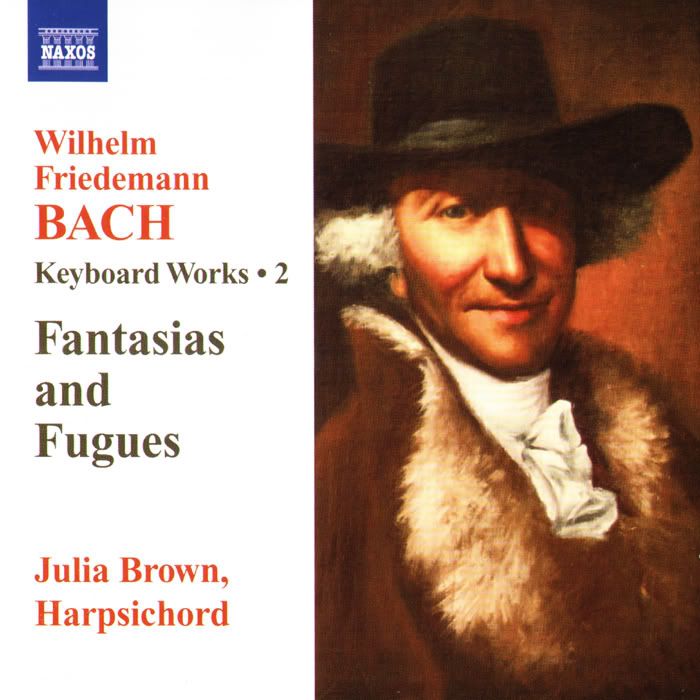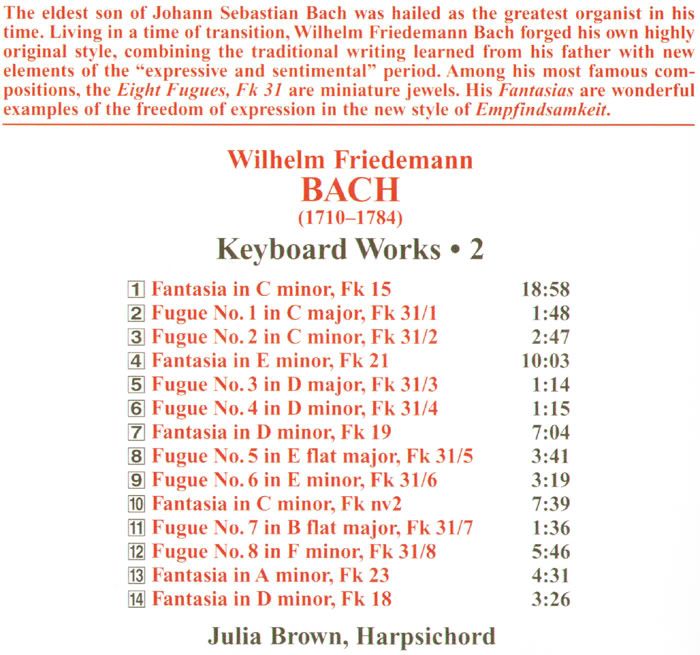 |
| NetLab · Rules · Torrent Tracker · Have a problem? · Eng/Rus |
 Help Help
 Search Search
 Members Members
 Gallery Gallery
 Calendar Calendar
|
| Welcome Guest ( Log In | Register | Validation ) | Resend Validation Email |
|
Posted: 17-08-2008, 23:33
(post 1, #851912)
|
||||||||||||||||||
|
Pro Member Group: Members Posts: 695 Warn:0% |
Wilhelm Friedemann Bach (1710 - 1784) Keyboard Works Vol. 2 - Fantasias and Fugues Label: Naxos, 8.570530 Year: 2008 Performer: Julia Brown - harpsichord The eldest son of Johann Sebastian Bach, Wilhelm Friedemann was born on 22 November 1710 in Weimar and died in Berlin on 1 July 1784. He was first taught by his father and after 1723, when the family moved to Leipzig, he became a student at the Thomasschule. He spent four years studying law at the University of Leipzig before finding employment as organist at the Sophienkirche in Dresden for thirteen years. At this time Dresden was a centre for operatic and theatrical performances; the opulent surroundings offered a distinct contrast to the austere Bach household. In 1746 Wilhelm Friedemann left liberal and glamorous Dresden for a post as organist at the Liebfrauenkirche in Halle, the centre of Pietism. The atmosphere was more strict, and music was suffered only as a means of "inspiring and refreshing the congregation in worship" - as stated in Friedemann’s contract. From 1764 until his death twenty years later he held no official position, although he had been widely recognised as one of the most distinguished organists of his time. In 1774 he left for Berlin, where he spent his last years living from the earnings of a few concerts, teaching, and the support of benefactors. Friedemann Bach was greatly admired for his virtuosity as a keyboard player and organist. A 1774 account of one of his public performances mentions it had "just the right ingredients to set the pulse racing, fresh ideas, striking changes of key, dissonant movements ..." As a composer, contemporary writings mention the enormous compositional density, intricacy and artistry of his works. In spite of the elements of sudden contrast and lightness, Friedemann incorporates enough traditional traits for his compositions to be regarded by his contemporaries as oldfashioned and complex. The eighteenth century was a time of change, both in people’s outlook on the universe as well as music aesthetics. Friedemann’s music is marked by both conservative and progressive elements; he shifts back and forth between old and new, between contrapuntal writing and simple melodic lines. This vacillation is attractive and it creates his highly personal style, filled with changes in expression and sudden surprises. What remains of Friedemann Bach’s output is probably a mere fraction of what once existed. With few exceptions, his compositions were disseminated only in the form of manuscript copies, though they were highly valued in some circles. In spite of this situation, we have examples of sonatas, fantasias, polonaises, a suite, fugues and shorter pieces for clavier (harpsichord, clavichord or fortepiano). Along with the Polonaises, F 12 [Naxos 8.557966], Friedemann’s Eight Fugues, Fk 31, are his most famous pieces; they were widely disseminated in the late eighteenth and early nineteenth centuries. Manuscript copies of this collection were available from music dealers in Berlin, Hamburg, Leipzig and Vienna. We also have an authorised copy with a dedicatory letter to Princess Anna Amalia of Prussia, dated 24th February 1778, and a complete autograph. These fugues are characterized by highly individualised themes and the predominance of free episodes. The variety of affects used and the highly individualized subjects makes them sound more like character pieces. They are all three-part fugues, and are small masterpieces of formal concision and thematic development; they are arranged in order of key, beginning with C major. The final Fugue in F minor is larger in scope, and the chromatic theme lends itself to very dramatic and discordant passages. Fantasy was taught as the supreme goal of practical musicianship, as in Carl Philipp Emanuel Bach’s keyboard method. Contemporary accounts describe eighteenth century masters of the keyboard frequently improvising. The fact that fewer Fantasias were published does not mean that they were less prevalent. If they were written down at all, they were intended as instructive examples for students. According to Carl Philipp, in a Fantasy "the clavierist has all the freedom possible", and harmonic daring, surprises "and any other reasonable deception make a fantasy good". No autograph copies have come down to us for Friedemann’s Fantasias, only secondary undated ones. The lack of autograph sources creates problems of misattribution and questions in a chronological investigation. It is possible that all the Fantasias were composed after Friedemann left his post at the Marienkirche in Halle – a time when he was most active as an independent keyboard virtuoso performer. The ornaments used and the wide keyboard range required for most of the Fantasias also indicate that these were written during Friedemann’s mature years. His Fantasias hold a fascinating originality, balancing between traditional and modern writing. They are filled with contrasting sections: some fugal writing (as the Fantasia in D minor, Fk 19), Alberti bass and recitatives (as in Fantasia in E minor, Fk 21), sections without barlines (Fantasia in A minor, Fk 23), quick changes in mood and tempo (as in Fantasia in C minor, Fk 15). This last was commissioned by the Baltic baron Ulrich Georg von Behr (1745-1813). These Fantasias are multi-sectional, and their improvisatory character can be felt through the frequent changes in texture, tempo and key. Each piece is highly individual in the way it combines contrasting and divergent sections. Fk 15 and 19 are the only fantasias that employ fugal sections. Fk 19 is comprised of three sections, each also in three-part form, with broken chords in a toccatastyle that begins and ends the work. Fk 21 in E minor incorporates highly expressive instrumental recitative writing and cantilena sections with recurring Furioso sections. Fk 18 and 23 are both shorter in length. It is possible to imagine that these served as starting points for free improvisations. Fk 18 in D minor is filled with scales and arpeggios, and is written in da capo form, briefly interrupted by a Larghetto section in F. The charming A minor Fantasia, Fk 23, begins with a long section of contrasting tempo markings with no bar lines, then abruptly ends with a Prestissimo section. The Fantasia in C minor from the Berlin manuscript P 883 has been attributed to Wilhelm Friedemann because it bears his name on the title page of the manuscript, although it is possibly a composition of Johann Wilhelm Hassler. This is one of many examples in Friedemann’s output demonstrating the difficulty of attribution and dating as a result of the lack of printed material and the manner in which the manuscripts were disseminated during Friedemann’s lifetime and later. Many questions remain as to the most appropriate instrument for performing these works. The word ‘clavier’ encompasses many possibilities. The clavichord is known to have been the favourite instrument of the Empfindsamkeit (the expressive and sentimental period); the pianoforte was gaining popularity, and the harpsichord was at the height of its development. In the case of the Fugues, Fk 8, these are also successfully performed on the organ. Although performed on the harpsichord for this recording, each of the possible instruments can bring a unique flavour and colour to the interpretation of the works of this gifted composer.   LOG
This post has been edited by kgkk on 18-08-2008, 00:25 |
||||||||||||||||||
|
|||||||||||||||||||
|
Posted: 17-08-2008, 23:38
(post 2, #851913)
|
||
|
Pro Member Group: Members Posts: 695 Warn:0% |
Первь том можно скачать здесь - http://torrent.e2k.ru/details.php?id=14956 This post has been edited by kgkk on 17-08-2008, 23:45 |
||


Powered by Invision Power Board v1.3.1 Final.

